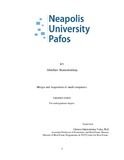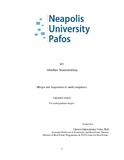| dc.description.abstract | Any business has two basic variants of the growth strategy - own organic development or
acquisition of external structure. In the process of constant development based on the existing
management of the company strategy it defines what is at that particular moment the most
profitable: the channeling of resources for the acquisition of new businesses or their
redistribution within the existing business lines. Accordingly, the purpose of acquiring new
business through the processes of mergers and acquisitions is to provide the company a strategic
advantage by joining and integrating new items of business, which should be more efficient than
their internal development within the company.
Basic principles for the development of large companies in the 80s - saving, flexibility,
maneuverability and compactness - in the second half of the 90s gave way to a focus on
expansion and growth. Large companies tend to seek additional resources to expand its activities,
among them one of the most popular is the mergers and acquisitions. The merger - one of the
most common methods of development, to which nowadays even very successful companies
apply to. This process is in the market environment becomes a common phenomenon, almost
casual.
In the economic literature there are different approaches to the definition and classification of
mergers and acquisitions. In the narrow sense of a merger refers to the transfer of all rights and
obligations of the two or more companies to the new legal entity in the process of reorganization.
Accordingly, absorption is considered to be the discontinuation of one or more companies with
the transfer of all their rights and obligations to another legal entity. Broadly speaking, mergers
and acquisitions due to the transition of control over the activities of companies, which can be
both formal and informal.
The narrow understanding of mergers and acquisitions comes from the legal definition of
reorganization of legal entities, which are forms of mergers and acquisitions. Reorganization of
companies as defined by the Civil Code and the Law "On Joint Stock Companies", means a
change in the legal status of one or more entities involved in the reorganization. Any legal person
may change its legal status by using only one of the ways specified by the law. Forms of
companies restructuring can be divided into two groups: without the involvement of existing
organizations - reorganization by division, separation or transformation, and with the
participation of existing legal entities - the reorganization by merger or acquisition of companies.
Merger and Consolidations – transaction/deals/agreements, accompanied by the emergence of a
new company formed by two or earlier. This new company takes control and management of all
assets and liabilities of companies - its components, after which the latter are dismissed.
Acquisitions - taking by one company (parent company) under its control another company
(subsidiary company), managing process of the parent company already with acquisition of an absolute or partial ownership on the subsidiary; often carried out by purchasing shares of the
acquired company (subsidiary) on the market.
Purpose of this work is to study such phenomena as mergers and acquisitions - or M & A.
To achieve this goal, this paper discusses the basic types, types and methods of mergers with
examples from the U.S. economy, the key characteristics of the motivations for mergers and
acquisitions, the classification of methods of protection against a hostile takeover. Will also be
given to historical background of, and development of the M & A.
Among the issues under examination - the theoretical aspects of mergers and acquisitions, their
basic classification, analysis of possible ways to assess the effectiveness of mergers and
acquisitions.
In today's international business is very important to distinguish between types of mergers and
acquisitions , to identify the main objectives pursued by the parties at the inception of a merger
or acquisition , to assess the effectiveness of such a transaction and its possible consequences.
If the company faces takeover by another firm, then this issue must be prepared very carefully:
anti gripping or take timely measures to actively (and most importantly, to successfully!)
Approved in the world or their actions to achieve favorable conditions for itself absorption,
remembering that in most cases, paradoxically, as a result of this transaction benefits not
absorbing and the absorbed company. It is only necessary to try to increase this gain.
Theoretical and applied problems associated with the process of mergers and acquisitions, and
adequately studied in detail by foreign authors. In Russian literature, interest in the problems of
mergers and acquisitions by legal scholars clearly manifested in the last decade. In connection
with what materials are used in the periodicals, monographs, experts in the field of corporate
finance, as well as foreign sources. For example, the fundamental work "The Art of M & A” -
Alexander Reid Lajoux authors, Stanley Foster Reed. Also a number of online resources - site
mergers.ru sites and international organizations (World Bank, IMF, industry organizations and
sites, etc.).
Mergers and acquisitions are usually caused by two reasons:
1) Commitment to lead the global markets (mergers and acquisitions open the way to new
markets);
2) The desire to take a favorable position in the industry in the future (to acquire the necessary
knowledge and experience). | en_UK |


